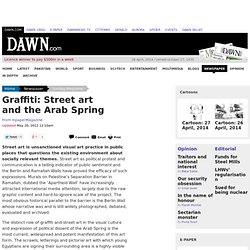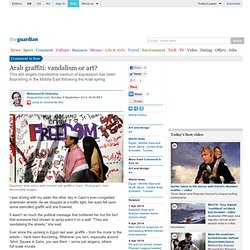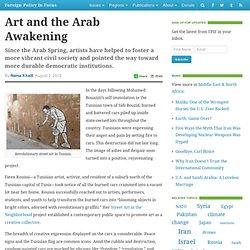

Graffiti: Street art and the Arab Spring. Street art is unsanctioned visual art practice in public places that questions the existing environment about socially relevant themes.

Street art as political protest and communication is a telling indicator of public sentiment and the Berlin and Ramallah Walls have proved the efficacy of such expressions. Murals on Palestine’s Separation Barrier in Ramallah, dubbed the ‘Apartheid Wall’ have increasingly attracted international media attention, largely due to the raw graphic content and hard-to-ignore scale of the project. The most obvious historical parallel to the barrier is the Berlin Wall whose narrative was and is still widely photographed, debated, evaluated and archived.
The distinct role of graffiti and street art in the visual culture and expression of political dissent of the Arab Spring is the most current, widespread and potent manifestation of this art form. Thrilling as the revolutionary period may be for artists, it is also fraught. The Arab Spring Brings Wave of Graffiti Art. Arab graffiti: vandalism or art? Egyptians walk past a wall covered with graffiti in Cairo.

Photograph: John Moore/Getty Images I was driving with my sister the other day in Cairo's ever-congested downtown streets. As we stopped at a traffic light, her eyes fell upon some stencilled graffiti and she frowned. It wasn't so much the political message that bothered her but the fact that someone had chosen to spray-paint it on a wall. "They are vandalising the streets," she said. Ever since the uprising in Egypt last year, graffiti – from the crude to the artistic – have been flourishing.
The Arab spring has brought regime change, but also a whole new dimension of social freedoms – and one aspect of that is the spread of graffiti. "Arab societies are conservative," Ahmed Shitawey a middle-class engineer with a taste for art observed. In Tunisia, eL Seed describes himself as a "calligraffiti" artist (since he mixes Arabic calligraphy and graffiti). He recently finished spray-painting a wall in his hometown of Gabès. Taking It to the Street. Art and the Arab Awakening. Revolutionary street art in Tunisia.

In the days following Mohamed Bouazizi’s self-immolation in the Tunisian town of Sidi Bouzid, burned and battered cars piled up inside state-owned lots throughout the country. Tunisians were expressing their anger and pain by setting fire to cars. This destruction did not last long. The image of ashes and despair soon turned into a positive, rejuvenating project. Faten Rouissi—a Tunisian artist, activist, and resident of a suburb north of the Tunisian capital of Tunis—took notice of all the burned cars crammed into a vacant lot near her home.
The breadth of creative expression displayed on the cars is considerable. One of Rouissi’s goals is to push the Tunisian ministry of culture to promote art in the public sphere. The visual landscape of the Arab World has changed greatly as various forms of creative expression have flourished in the days since the Arab Spring. Cultural Policy and Civil Society Nasr is an artist and an activist. Thinking Visually. West Bank Street Art: Palestinian artists have been inspired by Arab Spring upheavals. Arab Art as an Early Indicator of Revolution.